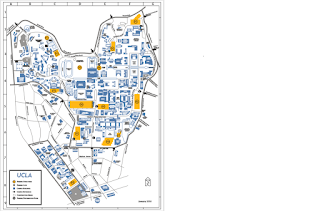Week 1 : Two Cultures
The main idea of the lecture 1, which deals with the importance of making the interactions between the arts/humanities and the sciences has played a role in bringing me a change of mind.
Before I took this class, as a student majoring in Electrical and Computer engineering, I thought that the technical knowledge and creativity, not using art or literature, was only needed to create or invent something. In addition, I thought that separating the arts and the sciences would not have a bad influence on developing both cultures. I have no doubt that many engineers have this perception as I did. C.P Snow, who wrote a book called "The Two Cultures and the Scientific Revolution", wanted to tell others that the literary and scientific culture are completely separate.
 Many people find it easy to understand, for the typical example, by looking at the location of the building in the UCLA. The university is currently divided into two cultures, with South Campus being located in major scientific buildings and North Campus being located in major literary buildings. It may or may not be the intent of the UCLA to clearly separate the two cultures as Snow's idea in the book, but the student will have no chance of encountering different cultures, which will inevitably lead the students to think that the science and literature are different and cannot coexist.
Many people find it easy to understand, for the typical example, by looking at the location of the building in the UCLA. The university is currently divided into two cultures, with South Campus being located in major scientific buildings and North Campus being located in major literary buildings. It may or may not be the intent of the UCLA to clearly separate the two cultures as Snow's idea in the book, but the student will have no chance of encountering different cultures, which will inevitably lead the students to think that the science and literature are different and cannot coexist. Figure 1)
Over time, a third culture that Vesna referred to is created by the interaction between art, literature, science. Even though artistic and scientific cultures have the different purpose as Kelly said "The purpose of science is to pursue the truth of the universe. Likewise, the aim of the arts is to express the human condition.", the third culture has two purposes. The third culture has helped us a lot, such as the prosthetic leg or eco-friendly building based on art and scientific technologies. I realize that experiencing and understanding about a variety of fields is very helpful in creating what I want. Therefore, I hope that the two cultures will become more and more communicative as they become closer to each other, rather than continue to fall.
Figure 3)
Figure 2)
Figure 1 - http://maps.ucla.edu/downloads/pdf/UCLA_Campus_Colored_Map.pdf
Figure 2 -http://neoearly.net/entry/%ED%98%B8%EB%B9%97%EC%9D%B4-%ED%8A%80%EC%96%B4%EB%82%98%EC%98%AC-%EA%B2%83-%EA%B0%99%EC%9D%80-%EC%8A%A4%EC%9C%84%EC%8A%A4%EC%9D%98-%EC%B9%9C%ED%99%98%EA%B2%BD-%ED%95%98%EC%9A%B0%EC%8A%A4-%EC%96%B4%EC%8A%A4-%ED%95%98%EC%9A%B0%EC%8A%A4Earth-House
Figure 3 - http://www.xn--9p4b13dh0bwd5iy7b.kr/board/bbs/board.php?bo_table=yl1j5iudiu&wr_id=11
Snow, Charles Percy. The Two Cultures and the Scientific Revolution: The Rede Lecture. London: Cambridge U P., 1959. Print
Vesna, Victoria. “Toward a Third Culture: Being in Between.” Leonardo, vol. 34, no. 2, 2001, pp. 121–125.
Kelly, Kevin. "The third culture." Science 279.5353 (1998): 992-993.




I was excited that you picked the example of the third culture as the prosthetic leg based on art and scientific technologies. I agreed that the separation of art and the science wouldn't mean anything, before the lecture. However, now I feel like they are inseparable since I see that they have so many connections and interactions between them and I hope the two cultures be more communicative so that we can actually develop both cultures as well.
답글삭제